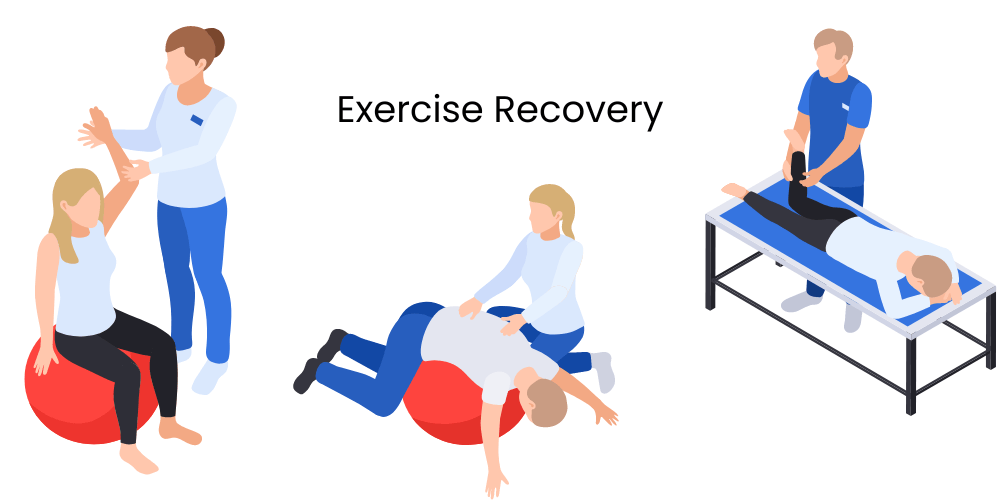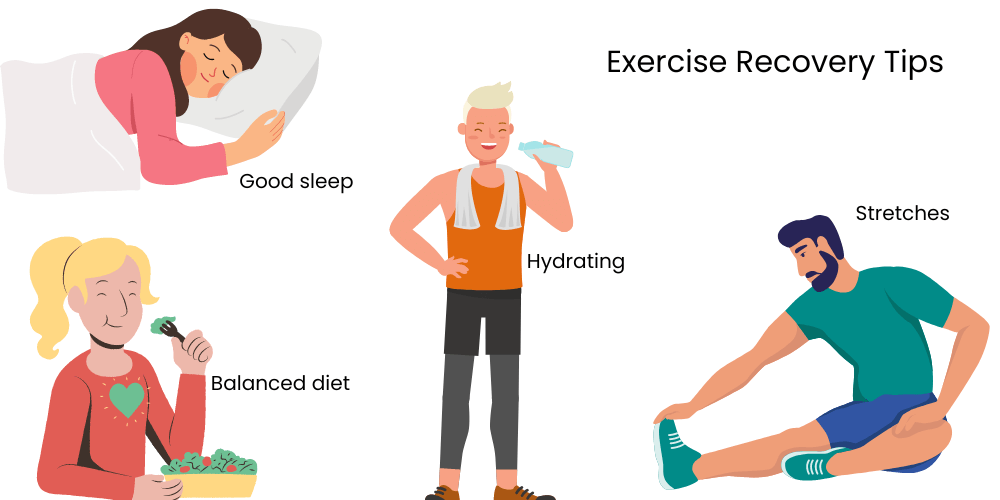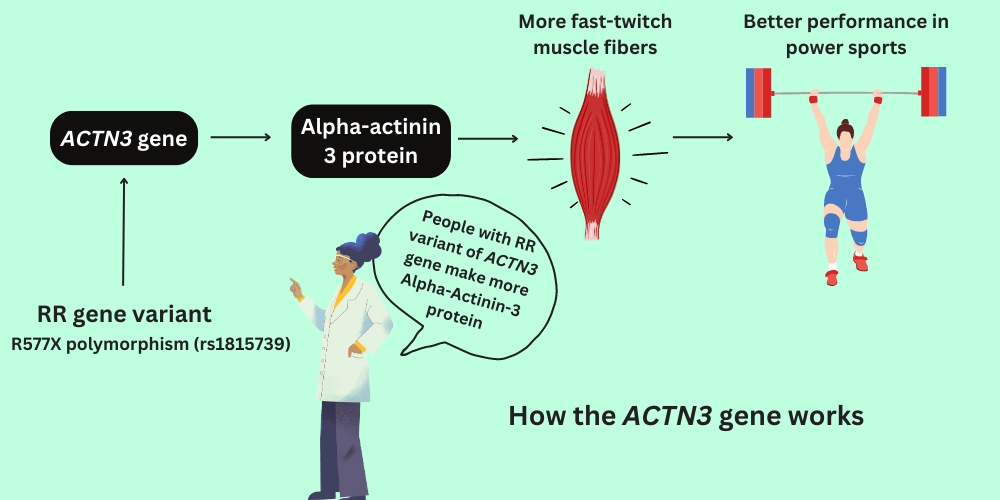Exercise Recovery: How Your Genes Can Help You

Table of Contents
Exercise plays a crucial role in maintaining physical health and wellness.
But the benefits of exercise extend far beyond the workout itself.
One key component of effective exercise is recovery.
This article aims to shed light on what exercise recovery is, why it’s important, and how our genetic makeup can influence it.
What is Exercise Recovery?
Exercise recovery is the process that happens in your body after a workout to repair any damage caused during exercise, and it’s a crucial part of staying healthy and improving fitness.
What happens when you exercise?
When you exercise, especially during high-intensity workouts, your muscles undergo small amounts of damage.
This damage is perfectly normal and is actually an essential part of building stronger muscles.
Your body responds to this damage by sending in repair teams, consisting of various proteins and cells, to fix the affected areas.

This process helps to build the muscles back stronger and larger than before, which is how you gain muscle mass and strength.
At the same time, during a workout, your muscles use up their stores of a substance called glycogen, which is a primary source of energy for your cells.
After you finish exercising, your body works to replenish these glycogen stores from the carbohydrates you consume, so your muscles are ready for the next workout.
Exercise also leads to a lot of sweat, which means you lose water and electrolytes.
These are important for maintaining the balance of fluids in your body and for your muscles to function correctly.
Drinking water or a sports drink after working out helps to rehydrate your body and replace the lost electrolytes.
The recovery process is not immediate and requires a certain amount of time, depending on how intense the exercise was, your fitness level, and your diet.
Getting enough sleep and eating a balanced diet, especially with sufficient protein, can help speed up the recovery process.

Section Summary
Exercise recovery is your body’s way of repairing, rebuilding, and strengthening your muscles after a workout.
It replenishes your energy stores and helps you get ready for the next exercise session.
What is Recovery Time in Exercise?
Recovery time in exercise refers to the duration your body needs to fully recover from the physiological stress caused by a workout.
This time can vary based on the intensity of the exercise, your fitness level, age, nutritional status, and even your genetics.
For example, after a high-intensity workout, the body might require a few hours to a couple of days to fully recover, whereas, after low-intensity or moderate exercises, a few hours might suffice.
Why is Recovery Important After Exercise?
Recovery is a crucial component of any exercise regimen because it allows the body to restore and increase its capacity for future exercise. Here are some reasons why recovery is vital:
- Prevention of Injuries: Sufficient recovery allows muscle tissues to repair and strengthen, reducing the risk of injuries.
- Muscle Growth: Muscles grow during the recovery period, not during the actual workout. This growth occurs as the body repairs the microscopic damage caused to the muscle fibers during exercise.
- Replenishment of Energy Stores: Recovery allows for the restoration of glycogen, a primary source of energy used during workouts.
- Prevention of Overtraining Syndrome: Overtraining syndrome occurs when the body doesn’t get enough recovery time and can lead to decreased performance, fatigue, and poor immune function.
Which Genes Influence Exercise Recovery?
Our genetic makeup can significantly influence how our bodies respond to and recover from exercise.
Here are a few of the key genes involved in this process:
ACTN3 Gene
The ACTN3 gene is commonly known as the “sprinter gene” and is responsible for encoding the protein alpha-actinin-3, which is present in fast-twitch muscle fibers.

These types of fibers are responsible for producing forceful, rapid muscular contractions, such as those required during sprinting or weightlifting.
There’s a specific variant of the ACTN3 gene (R577X) where the R allele provides a fully functioning alpha-actinin-3 protein, and the X allele doesn’t.
Individuals with the RR genotype typically have more fast-twitch muscle fibers and may recover quicker from high-intensity exercise, while those with the XX genotype may require longer recovery times due to their higher proportion of slow-twitch fibers.
IL6 Gene
The IL6 gene codes for interleukin-6, a cytokine involved in inflammation and the immune response.
Interleukin-6 levels rise in response to muscle damage, helping to stimulate the repair and recovery process.
Certain variants of the IL6 gene can influence the amount of interleukin-6 that’s produced during exercise, potentially impacting inflammation and recovery speed.
PPARGC1A Gene
The PPARGC1A gene influences the production of mitochondria in our cells.
Mitochondria are often referred to as the “powerhouses” of the cell, and they’re responsible for producing the energy our bodies need to function.
Individuals with certain variations in the PPARGC1A gene have been found to have more mitochondria in their muscle cells, which can potentially lead to quicker recovery following exercise as the cells can more efficiently produce and utilize energy.
VEGF Gene
VEGF (Vascular Endothelial Growth Factor) is a gene that affects the growth of blood vessels.
After exercise, the body needs to deliver nutrients and oxygen to the muscles to aid in recovery.
The VEGF gene can influence how quickly and effectively this happens by affecting blood vessel growth and function.
Variations in this gene can influence recovery speed and efficacy.
| Gene | SNP | Description |
|---|---|---|
| ACTN3 | rs1815739 | The C allele (resulting in an X) leads to a stop codon, meaning less functional alpha-actinin-3 protein is produced. This can result in slower recovery times. The T allele (resulting in an R) is associated with normal production of alpha-actinin-3, often leading to quicker recovery times. |
| IL6 | rs1800795 | The G allele is associated with a higher production of interleukin-6, which could potentially lead to increased inflammation but also potentially faster muscle recovery. The C allele is linked to lower production of interleukin-6, which could potentially result in slower recovery. |
| PPARGC1A | rs8192678 | The G allele is linked with increased production of mitochondria, potentially leading to faster recovery times. The A allele is associated with standard mitochondrial production, which may result in average recovery times. |
| VEGF | rs2010963 | The G allele is associated with higher VEGF production and potentially better blood vessel growth and recovery. The C allele is associated with lower VEGF production, which may slow recovery. |
These are only a few of many genetic variants that might influence exercise recovery, and the effects can also be modified by other genetic and environmental factors.
As such, the information should be used as part of a broader assessment of exercise recovery.
Section Summary
Understanding the influence of these genes can help tailor a personalized approach to exercise and recovery, but it’s important to remember that other factors like diet, sleep, and stress levels also play a crucial role in exercise recovery.
Non-Genetic Factors Influencing Exercise Recovery
Exercise recovery is a complex process influenced by many non-genetic factors.
Here are several key elements that contribute to how well and how quickly your body recovers after a workout:
Nutrition
Your body needs the right nutrients to repair and rebuild tissues and replenish energy stores after a workout.
Key nutrients include:
- Proteins: They provide the building blocks, known as amino acids, that are needed for muscle repair and growth.
- Carbohydrates: They replenish glycogen stores, which serve as a primary energy source for muscles during exercise.
- Fats: Although not immediately used for recovery, fats are essential for overall health and the absorption of certain nutrients.
- Micronutrients: Vitamins and minerals, like vitamins C, D, calcium, and iron, are involved in various aspects of recovery, including tissue repair, inflammation reduction, and immune function.
Hydration
Proper hydration is essential for optimal recovery.
Water supports every metabolic function in your body, including the process of recovery.
During exercise, the body loses water and electrolytes through sweat.
Rehydrating helps restore fluid balance, aids in nutrient transport, and supports optimal metabolic function.
Sleep
Sleep is a powerful recovery tool because many restorative functions occur primarily or solely during sleep.
These include tissue repair, muscle growth, and the release of certain hormones related to growth and appetite.
Lack of sleep can impede recovery, impair performance, and increase the risk of injuries.
Stress Management
Chronic stress can slow the recovery process and increase the risk of injuries and overtraining.
That’s because it stimulates the production of cortisol, a hormone that can inhibit various recovery processes, including protein synthesis needed for muscle repair.
Active Recovery
Active recovery, such as light exercises and stretching on your rest days, can enhance blood flow, which helps deliver nutrients to muscles and remove waste products.
This process can reduce muscle soreness and speed up the recovery process.
Age and Fitness Level
Older individuals and those new to exercise may find that their bodies take longer to recover compared to younger individuals or those who are more physically fit.
This is a normal part of the aging process and the body’s adaptation to new physical stresses.
In summary, many non-genetic factors contribute to exercise recovery.
By optimizing these factors, individuals can enhance their recovery process, improve performance, and reduce the risk of injury.
Tips to Improve Exercise Recovery Based on Your Genes
Understanding your genetic predispositions can provide a unique and personalized way to approach exercise recovery.
Here are some tips to improve exercise recovery based on your genetic makeup:
Pay Attention to Rest and Recovery
Individuals with certain ACTN3 or IL6 genetic variants might require longer recovery periods due to slower muscle repair or greater inflammation.
In such cases, ensuring adequate rest between intense workouts is critical.
This could mean more rest days or incorporating more low-intensity or restorative exercises like yoga or stretching into your routine.
Adapt Your Exercise Type and Intensity
Your genetic profile can also guide the types of exercise that might be best suited for you.
Those with an ACTN3 RR genotype might excel in high-intensity, power-based activities, while those with an XX genotype might find endurance-based activities more beneficial.
By tailoring your exercise regimen to your genetic predispositions, you can optimize both performance and recovery.
Personalize Your Nutrition
Nutrition plays a critical role in exercise recovery, and genetic information can help tailor your diet to support this.
For example, if your genetic profile shows a faster rate of muscle breakdown or inflammation (such as certain ACTN3 or IL6 variants), you might need higher protein intake or more anti-inflammatory foods to support recovery.
Adjust Your Hydration
Certain genetic variants can affect electrolyte balance and hydration needs.
Those with such variants might need to pay extra attention to hydration before, during, and after exercise to support optimal recovery.
Utilize Active Recovery
Some individuals might recover better with active recovery techniques, such as light exercises or stretching, based on their genetic profiles.
Understanding your genetic predispositions can help you determine the most effective recovery strategies for you.
While these tips can provide personalized strategies for improving exercise recovery, it’s important to remember that many factors contribute to recovery.
It’s always a good idea to consult with a healthcare provider or a fitness professional when making significant changes to your exercise or recovery routines.
Diet Tips to Improve Exercise Recovery Based on Your Genes
Nutritional needs for recovery can also be guided by genetics.
Those with certain IL6 gene variations might benefit from an anti-inflammatory diet to assist recovery, while variations in genes like PPARGC1A might mean you require more carbohydrates to replenish energy stores quickly.
Summary
Q: What is exercise recovery? A: Exercise recovery is the time following physical activity when your body repairs and replenishes itself.
Q: How long should recovery time be after exercise? A: Recovery time varies based on many factors, including the intensity of the exercise, your fitness level, and your genetics.
Q: Why is recovery after exercise important? A: Recovery is vital to prevent injuries, allow muscle growth, replenish energy stores, and avoid overtraining.
Q: Do genes influence exercise recovery? A: Yes, several genes, including ACTN3, IL6, PPARGC1A, and VEGF, can influence your exercise recovery.
Q: Can my diet affect exercise recovery? A: Absolutely, adequate protein and carbohydrates are essential for muscle repair and energy replenishment. Additionally, your genetic makeup can guide specific dietary strategies to optimize recovery.
References
- Bompa, T.O., Haff, G. (2009). Periodization: Theory and Methodology of Training. Human Kinetics.
- Clarkson, P. M., & Hubal, M. J. (2002). Exercise-induced muscle damage in humans. American journal of physical medicine & rehabilitation, 81(11), S52-S69.
- Nieman, D. C., & Wentz, L. M. (2019). The compelling link between physical activity and the body’s defense system. Journal of Sport and Health Science, 8(3), 201–217.
- Pescatello, L.S., & Roth, S.M. (2013). Genomics and Molecular Biology in Exercise and Sport. In: Bouchard C., Hoffman E.P. (eds) Genetic and Molecular Aspects of Sport Performance. Blackwell Publishing Ltd.
- Tipton, K. D., & Ferrando, A. A. (2008). Improving muscle mass: response of muscle metabolism to exercise, nutrition and anabolic agents. Essays in biochemistry, 44, 85-98.
Written By
Share this article












